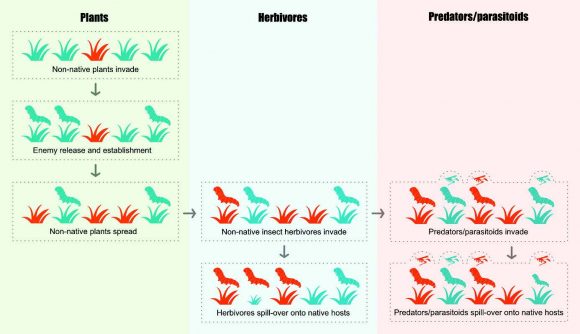An international team of researchers, including Prof Dave Richardson of the Centre for Invasion Biology, recently published a paper that shows plant invasions are a major driver of of insect invasions.
Invasions by non-native insect species can cause massive disruptions to biodiversity and ecological processes which often result in serious economic impacts. The trend of increasing numbers of insect invasions worldwide can be traced to a large extent to the increasing volume global trade and travel which results in the accidental transport of insects to new regions. Climate change can also create conditions that facilitate the establishment of non-native insects.
However, there is another reason for the growing number of insect invasions that has garnered less attention. This reason is that the increase of non-native plants worldwide is creating many new ecological ‘niches’ for plant-feeding insects, thereby facilitating the establishment of a growing number of these insect species outside their native ranges and in areas where their hosts are planted or are invasive. Around the world, non-native plants are increasingly common, either as a result of them being planted for purposes of ornamental landscaping, agriculture and forestry. Furthermore, many species of invasive plants are spreading and displacing native species.
In their paper, published in BioScience, the team synthesised (1) the mechanisms by which plant invasions facilitate insect invasions; (2) the broad-scale patterns that shed light on the link between plant and insect invasions and; (3) case studies of plant invasions that have facilitated subsequent insect establishment.
The body of evidence summarized in the paper shows that plant invasions are a major driver of insect invasions. This provides additional justification for ramping up efforts aimed at limiting the global spread of non-native plants – to avert the proliferation of non-native insects and their spillover onto native plant species.
Worryingly, the assembled evidence also suggests a massive ‘invasion debt’ – many thousands of planted and naturalized non-native plants are waiting to welcome insects from their native ranges thereby launching many more potentially damaging invasions. The stage has unfortunately been set for growing problems with insect invasions in the future. This heightens the value of national and international biosecurity programs targeting the exclusion of potentially damaging species.
Read the paper in BioScience
Cleo Bertelsmeier, Aymeric Bonnamour, Eckehard G Brockerhoff, Petr Pyšek, Jiří Skuhrovec, David M Richardson, Andrew M Liebhold, Global proliferation of nonnative plants is a major driver of insect invasions, BioScience, 2024. https://doi.org/10.1093/biosci/biae088
For more information, contact Dave Richardson at rich@sun.ac.za




